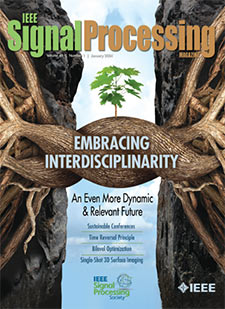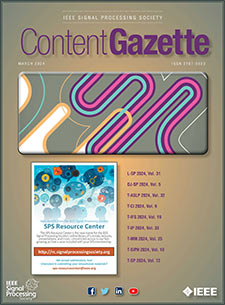- Our Story
- Publications & Resources
- Publications & Resources
- Publications
- IEEE Signal Processing Magazine
- IEEE Journal of Selected Topics in Signal Processing
- IEEE Signal Processing Letters
- IEEE/ACM Transactions on Audio Speech and Language Processing
- IEEE Transactions on Computational Imaging
- IEEE Transactions on Image Processing
- IEEE Transactions on Information Forensics and Security
- IEEE Transactions on Multimedia
- IEEE Transactions on Signal and Information Processing over Networks
- IEEE Transactions on Signal Processing
- IEEE TCI
- IEEE TSIPN
- Data & Challenges
- Submit Manuscript
- Guidelines
- Information for Authors
- Special Issue Deadlines
- Overview Articles
- Top Accessed Articles
- SPS Newsletter
- SigPort
- SPS Resource Center
- Publications Feedback
- Publications FAQ
- Blog
- News
- Dataset Papers
- Conferences & Events
- Community & Involvement
- Professional Development
- For Volunteers
- Information for Authors-OJSP
-
Home
Conferences Events IEEE JSTSP Article IEEE Signal Processing Magazine IEEE TIFS Article IEEE TMM Article IEEE TSP Article Jobs in Signal Processing Lectures Machine Learning Seasonal Schools Signal Processing News SPM Article SPS Distinguished Lectures SPS Newsletter Article SPS Webinar SPS Webinars SPS Webinar Series Webinar webinars
-
Our Story
What is Signal Processing?

The technology we use, and even rely on, in our everyday lives –computers, radios, video, cell phones – is enabled by signal processing. Learn More » -
Publications & Resources
-
SPS Resources
- Signal Processing Magazine The premier publication of the society.
- SPS Newsletter Monthly updates in Signal Processing
- SPS Resource Center Online library of tutorials, lectures, and presentations.
- SigPort Online repository for reports, papers, and more.
- SPS Feed The latest news, events, and more from the world of Signal Processing.
-
SPS Resources
-
Conferences & Events
-
Community & Involvement
-
Membership
- Join SPS The IEEE Signal Processing Magazine, Conference, Discounts, Awards, Collaborations, and more!
- Chapter Locator Find your local chapter and connect with fellow industry professionals, academics and students
- Women in Signal Processing Networking and engagement opportunities for women across signal processing disciplines
- Students Scholarships, conference discounts, travel grants, SP Cup, VIP Cup, 5-MICC
- Young Professionals Career development opportunities, networking
- Get Involved
-
Technical Committees
- Applied Signal Processing Systems
- Audio and Acoustic Signal Processing
- Bio Imaging and Signal Processing
- Computational Imaging
- Image Video and Multidimensional Signal Processing
- Information Forensics and Security
- Machine Learning for Signal Processing
- Multimedia Signal Processing
- Sensor Array and Multichannel
- Signal Processing for Communication and Networking
- Signal Processing Theory and Methods
- Speech and Language Processing
- Technical Working Groups
- More TC Resources
-
Membership
-
Professional Development
-
Professional Development
- Mentoring Experiences for Underrepresented Young Researchers (ME-UYR)
- Micro Mentoring Experience Program (MiME)
- Distinguished Lecturer Program
- Distinguished Lecturers
- Distinguished Lecturer Nominations
- Past Lecturers
- Distinguished Industry Speaker Program
- Distinguished Industry Speakers
- Distinguished Industry Speaker Nominations
- Industry Resources
- IEEE Training Materials
- Jobs in Signal Processing: IEEE Job Site
-
Career Resources
- SPS Education Program Educational content in signal processing and related fields.
- Distinguished Lecturer Program Chapters have access to educators and authors in the fields of Signal Processing
- PROGRESS Initiative Promoting diversity in the field of signal processing.
- Job Opportunities Signal Processing and Technical Committee specific job opportunities
- Job Submission Form Employers may submit opportunities in the area of Signal Processing.
-
Professional Development
-
For Volunteers
-
For Board & Committee Members
- Board Agenda/Minutes* Agendas, minutes and supporting documentation for Board and Committee Members
- SPS Directory* Directory of volunteers, society and division directory for Board and Committee Members.
- Membership Development Reports* Insight into the Society’s month-over-month and year-over-year growths and declines for Board and Committee Members
-
For Board & Committee Members
Popular Pages
Today's:
- Submit a Manuscript
- Information for Authors
- Dataset Resources
- (ACSSC 2024) 2024 Asilomar Conference on Signals, Systems, and Computers
- (MLSP 2024) 2024 IEEE International Workshop on Machine Learning for Signal Processing
- (SLT 2024) 2024 IEEE Spoken Language Technology Workshop
- IEEE Journal of Selected Topics in Signal Processing
- Conference Call for Papers
- IEEE/ACM Transactions on Audio Speech and Language Processing
- IEEE Transactions on Multimedia
- IEEE Signal Processing Letters
- IEEE Transactions on Information Forensics and Security
- Board of Governors
- (ICIP 2025) 2025 IEEE International Conference on Image Processing
- IEEE Transactions on Image Processing
All time:
- Information for Authors
- Submit a Manuscript
- IEEE Transactions on Image Processing
- 404 Page
- IEEE/ACM Transactions on Audio Speech and Language Processing
- IEEE Transactions on Information Forensics and Security
- IEEE Transactions on Multimedia
- IEEE Signal Processing Letters
- IEEE Transactions on Signal Processing
- Conferences & Events
- IEEE Journal of Selected Topics in Signal Processing
- Information for Authors-SPL
- Conference Call for Papers
- Signal Processing 101
- IEEE Signal Processing Magazine
Last viewed:
- Submit a Manuscript
- Guidelines for Reviewers
- BISP TC Home
- IEEE Signal Processing Letters
- IEEE JSTSP Special Issue on Array Signal Processing for Angular Models in Massive MIMO Communications
- (ICASSP 2025) 2025 IEEE International Conference on Acoustics, Speech and Signal Processing
- IEEE Transactions on Multimedia
- IEEE JSTSP Special Issue on Advanced Signal Processing for Reconfigurable Intelligent Surface-aided 6G Networks
- Publications FAQ
- IEEE Transactions on Image Processing
- IEEE JSTSP Special Issue on Learning-Based Signal Processing for Integrated Sensing and Communications
- Editorial Board Nominations
- IEEE JSTSP Special Issue on Intelligent Robotics: Sensing, Signal Processing and Interaction
- Registration open: IEEE SPS/EURASIP Summer School on Robust Signal Processing
- (MLSP 2024) 2024 IEEE International Workshop on Machine Learning for Signal Processing
Taking Compressive Sensing to the Hardware Level
You are here
Newsletter Menu
Newsletter Categories
Top Reasons to Join SPS Today!
1. IEEE Signal Processing Magazine
2. Signal Processing Digital Library*
3. Inside Signal Processing Newsletter
4. SPS Resource Center
5. Career advancement & recognition
6. Discounts on conferences and publications
7. Professional networking
8. Communities for students, young professionals, and women
9. Volunteer opportunities
10. Coming soon! PDH/CEU credits
Click here to learn more.
News and Resources for Members of the IEEE Signal Processing Society
Taking Compressive Sensing to the Hardware Level
Compressive sensing (CS) theory opens promising avenues toward building rapid and energy-efficient sensing systems in a wide range of applications that require inherently high temporal and/or spatial resolution while exhibiting a sparse signal structure. CS facilitates a sampling theory that allows for signal recovery using fewer measurements than required by the Shannon-Nyquist sampling theorem. Previous hardware solutions based on the Shannon-Nyquist sampling theorem suffer from fixed tradeoffs between scan time and power consumption. Moreover, trading power for reduced scan time, which can significantly increase the complexity of the hardware, does not improve its overall energy consumption. In contrast, CS leverages the usage of signal structure, such as sparsity or compressibility in an appropriately chosen transform basis, to enable new tradeoffs with substantial improvements to both time and energy per scan.
Applications requiring a high-resolution acquisition of structured sparse signals are ideal candidates for CS. Some obvious application fields that could benefit from CS include medical diagnostics, weather forecasting, wireless communications, autonomous vehicles, and video systems.
The goal of this article Taking Compressive Sensing to the Hardware Level written by R. T. Yazicigil, T. Haque, and etc. published in IEEE Signal Processing Magazine in March 2019 is to review recent efforts to realize the benefits of CS in custom sensing hardware and the broad challenges that arise by investigating an example application in radio-frequency (RF) communications. The authors discuss in detail how using CS for the design of RF spectrum scanners can break through the fixed tradeoffs among scan time, hardware complexity, and energy consumption of traditional scanner architectures. Using the specific example of RF spectrum sensing, the authors demonstrate how close collaborations between hardware and signal processing experts can yield new solutions that advance the state of the art in an important application domain. The authors stress the problems that arise when designing a custom hardware for CS and address questions that often go beyond the currently available literature in CS, e.g., coping with the impairments of real hardware and avoiding catastrophic breakdown when the spectrum becomes nonsparse.
Open Calls
Publications News
PhD Theses
Chapter & DL News
TC News
Society News
Initiatives & Trends
SPS on Twitter
- DEADLINE EXTENDED: The 2023 IEEE International Workshop on Machine Learning for Signal Processing is now accepting… https://t.co/NLH2u19a3y
- ONE MONTH OUT! We are celebrating the inaugural SPS Day on 2 June, honoring the date the Society was established in… https://t.co/V6Z3wKGK1O
- The new SPS Scholarship Program welcomes applications from students interested in pursuing signal processing educat… https://t.co/0aYPMDSWDj
- CALL FOR PAPERS: The IEEE Journal of Selected Topics in Signal Processing is now seeking submissions for a Special… https://t.co/NPCGrSjQbh
- Test your knowledge of signal processing history with our April trivia! Our 75th anniversary celebration continues:… https://t.co/4xal7voFER
Home | Sitemap | Contact | Accessibility | Nondiscrimination Policy | IEEE Ethics Reporting | IEEE Privacy Policy | Terms | Feedback
© Copyright 2024 IEEE – All rights reserved. Use of this website signifies your agreement to the IEEE Terms and Conditions.
A not-for-profit organization, IEEE is the world's largest technical professional organization dedicated to advancing technology for the benefit of humanity.









